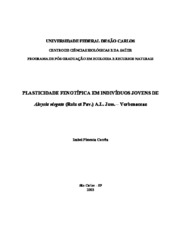Plasticidade fenotípica em indivíduos jovens de Aloysia virgata (Ruiz et Pav.)
Abstract
Phenotypic plasticity in a tree species Aloysia virgata was investigated on seedlings
growing under two different natural irradiance conditions: under full solar irradiance (FS) and
in shade under tree forest canopy (UC). Seedlings with 180 days old cultivated under FS
showed significant (p<0.001, n=12) larger average values of biometrics (height, diameter of
stem, number of leaves and total leaf area), and biomass (root, stem, and leaves) parameters.
Carboxilation efficiency (CE), and potential photosynthetic capacity (on mass or on area
bases) were greater in seedlings that grew under FS. In addition, the instantaneous nutrient use
efficiency determined to N, P, K, Ca, Mg, and S in curves of net photosynthesis as a function
of substomatal CO2 concentration, and the water use efficiency (between photosynthetic
active radiation greater than 250 µmol m-2 s-1) were higher in individuals under FS. Only the
root/shoot ratio average value was greater in shade condition. In spite of Aloysia virgata
showed greater average values of biometric, biomass, and gas exchange parameters under FS,
all UC individuals survived during 36 months. The high phenotypic plasticity showed under
contrasting irradiance was brought about by changes in several organization levels of the
plant, from mesophyll tissue (CE) until whole plant (biomass allocation). The high phenotypic
plasticity exhibited by Aloysia virgata can explain, at least in part, its vast distribution in several ecosystem and successional stages in South America.
